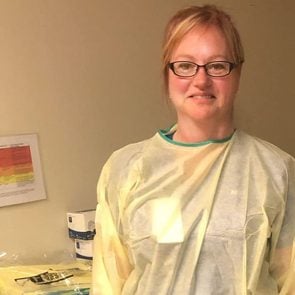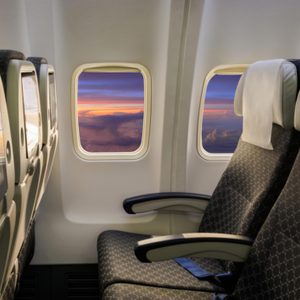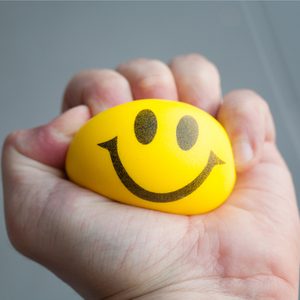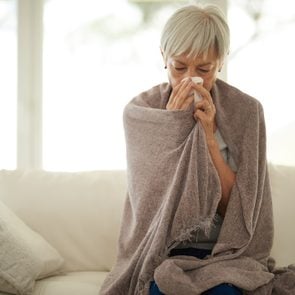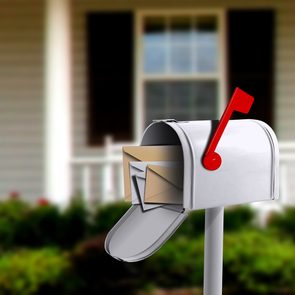
Benjamin Franklin once said, “In this world nothing can be said to be certain, except death and taxes.” Welp, as of a few weeks ago, not even taxes are certain.
These are unusual and very uncertain times. But in the wise words of Oprah, I know a few things for sure, even during the coronavirus pandemic:
-
Reese’s Eggs have been, and always will be, better than even the best regular peanut butter cups (stress-eating “experiment” results can confirm this to be true)
-
Flour + butter + sugar = a sort of soothing magic
From pies to cakes to cookies, I’ve been baking my way through self-isolation, and it’s most certainly been a huge sanity saver. Here’s why I can’t imagine being quarantined without my mixer, spatula, and oven—and why you might want to start preheating your oven now, too.
Baking takes me back to childhood
Every Christmas and Easter smelled like homemade cinnamon rolls. Each long weekend was scented with the yeasty goodness of fresh-baked bread. For the first 18 years of my life, I watched at my mom’s hip as she kneaded, rolled, and shaped baked goods for any and every family gathering.
Since then, whenever I’m feeling a bit lonely (say, during solo quarantine or post-breakup), I instantly find a sense of peace as soon as I bust out my measuring cups and spoons. So, on that Sunday when things started to get real—like cities-shut-down, Tom-Hanks-is-sick, my-ER-doc-sister-called-into-work real—I found a dose of serenity in mixing up a big batch of my mom’s Snickerdoodles.

Baking forces me to take a break from the news
Since I report on health, food, and more for my job as a freelance writer and editor, it’s helpful to stay current on the news. There reaches a point, though, when enough is too much—where staying informed becomes a downward spiral into feelings of anxiety and helplessness. Research backs this up: Repeated media exposure to traumatic scenes is actually more traumatic than witnessing the tragedy once in real life, according to research published in the Proceedings of the National Academy of Sciences. If I’ve checked in once in the morning and once in the afternoon and am tempted to dive into a news binge again, I instead dig out a new pie recipe on my continued quest to perfect a buttery, flaky pastry crust. Need some baking inspiration? Try these recipes for cakes to make when your cupboards are bare.
The repetition is about as zen as a yoga flow
An hour of daily at-home yoga using the Down Dog app has really helped throughout these first few weeks of quarantine. But woman cannot survive on sun salutation alone. After walking from mat to mixing bowl one day and kneading my Mom’s “famous” whole-wheat bread dough by hand, I realized that the process inspires a similar sense of flow. Fold, press, turn, repeat. After doing the same process about ten times, outside thoughts began to float away as I tuned into the stickiness of the dough, the tiny additions of flour, and the quiet peace found in just flour, honey, yeast, and salt.

It’s a way to connect with friends and family from afar
While I can’t host my parents or pals for a dinner party at my table for the next few months, I can drop off a no-contact delivery care package of their favourite kind of cookies. Even in steady-as-she-goes times of little stress, it’s become a bit of a signature for me to arrive at a coffee or cocktail hour outing with my rendition of that person’s favourite baked good to share. (I have a strong feeling that “acts of service” is my preferred love language.) So, I’ve become hyper-vigilant about hygiene and hand washing, then shared my baked goods via porch drop-offs and postal delivery. Check out more inspiring ways people are helping one another right now.
It gives me a sense of control over something
One of the more challenging parts of the pandemic to process (besides the fact that it can feel quite helpless to only be able to contribute to a solution by supporting small businesses, donating to nonprofits in need, and, most importantly, staying home) has been no sight of a finish line. When I’m taking a spin class, I know that at minute 45, a breath of fresh air outside awaits. At the end of a 60-minute cake recipe, my bundt will be ready to cool.
But no one is sure when things will be a bit more “normal”—or what this new normal will look like when we start inching toward a more regular routine. When we get there, though, I know this for sure: When that first group dinner party is allowed and safe, I’ll be there with a lot of gratitude for genuine human connection, for health, and for community. I’ll have some really big hugs ready. And lots of pie.
Find out more ways to get through the quarantine healthier, happier and smarter.
Particularly if you’re seated in economy class, no one is thrilled to find themselves squished next to a stranger or two for the duration of a flight. But, hey, we do what we’ve gotta do to get from point A to point B. Whether it’s for business, vacation, or to reconnect with family, air travel may be the most efficient way to accomplish these expeditions. However, when concerns about COVID-19 began ramping up in February, the already cramped quarters of an airplane truly felt like they were too close for comfort…and personal health. Here, one flight attendant shares her story. (She declined to name the airline she works for.)
Flight changes during coronavirus
I’m a Chicago-based flight attendant who has been working in the industry for under a year. To me, the travel loads seemed to be about the same throughout February and in early March. In fact, during early to mid-March, I had never seen airports and customs lines so long. Then, when there were discussions of borders closing and people were starting to understand that they may not be able to get to their home countries unless they were to head back immediately, flights were loaded with worried passengers. Around the middle of March, when states across the country began to mandate orders closing businesses and asking residents to shelter in place, I noticed people starting to take the news surrounding coronavirus more seriously, staying home, and cancelling travel plans.
Distance directives
Social distancing, the act of purposefully putting physical distance between you and another person, is difficult to do on an airplane. But both airline personnel and passengers have made a point to practice this as much as possible while in the air. Inflight, I acknowledge personal space more for myself and for the passengers. I try to keep as much distance as I’m able to provide. After arming and disarming my doors, I immediately wash my hands, I wipe down the intercom phones with sanitizer wipes before use it, and I carry Sani-com wipes in my uniform sweater pocket. (Find out more health tips from flight attendants who never get sick.)

Food for thought
The airline I work for is suspending food and beverage service on flights under 2,200 miles until further notice. Before the food suspension, we started giving full cans of sodas to passengers so we didn’t have to open it for them and stopped reusing cups for refills. I always wear gloves when I’m picking up trash—and that hasn’t changed.
The space between
There are so few people flying right now, personal space isn’t much of an issue. On a recent four-day trip (essentially, a flight attendant’s work shift before returning to their home base), each flight I worked has had such a light travel load that each passenger has easily been able to maintain at least 6-feet of distance from the next. Passengers flying during the pandemic are largely taking extra precautions, with most wearing masks and gloves, while also wiping down their seats and tray tables prior to sitting down.
Frequent fliers
Wondering who is still flying during these uncertain times? I’ve seen a lot of people visiting family last-minute in fear that domestic flights could be suspended.
Surprisingly, I’ve seen several people taking vacations right now too. Many airlines are offering flights as low as $18 one-way across the country and those low prices can be very tempting. This includes New Yorkers trying to escape the cold (and a tiny Manhattan apartment) by heading to Florida. (Editor’s note: The governor of Florida has issued a mandate that anyone arriving from the New York City area self-quarantine for 14 days after arrival.)

Risk factor
From my perspective, I don’t think anyone should be flying right now unless it’s absolutely essential. It puts tons of people that have to go into a physical workspace at risk, especially as airline personnel (flight attendants, pilots, gate agents, and customer service reps, just to name a few) are one of the few groups that are still required to go into work.
Job security
Furloughs haven’t been mentioned in an official capacity by the airline I work for; however, employees, discuss it as a very real probability. Airlines are offering voluntary leaves of absences and early retirement programs to offer time off or severance from the company to the people that would prefer that first. I’m one of the newer flight attendants so I assume I would be one of the first to be furloughed if it came to that. You can’t help but think about it and worry.
Safety first
I did take some sick days at the beginning of the pandemic because I was extremely nervous to fly knowing how many passengers would be on board. As flights became less full, I felt more comfortable flying again. There is a silver lining in an otherwise nerve-wracking time to fly: Planes seem to have never been cleaner. Though that’s not to suggest anyone should book a flight during the pandemic unless they absolutely have to travel. Next, find out the best place to sit on an airplane to avoid getting sick.
[single-card single_card_content_id=”240437″ title=”Coronavirus Symptoms to Watch Out for” image_id=”240417″ url=”https://www.readersdigest.ca/health/conditions/coronavirus-symptoms/”
Toilet paper, hand sanitizer, protective masks, Tylenol, flour and so many other items have suddenly become hot commodities as most Canadians hunker down at home during the coronavirus pandemic. This has left many people shopping in bulk as they attempt to be prepared not just for a possible two-week quarantine but for months—just in case. You’ve seen the empty shelves at the stores across the country. You’ve also likely seen the pictures of people’s garages stuffed with supplies, so if you find it, you’re going to buy it. After all, if you don’t, someone else will, you’ll be left with nothing and then what will happen?
Stop right there…and breathe. You’re panicking, and that’s causing you to engage in some aptly termed “panic buying.” While it might not seem like a big deal since you’re just one person, you’re adding to a larger problem and causing serious harm in ways you don’t realize. “Panic buying is an act of selfish madness,” says Paul Hong, professor of global supply chain management and Asian studies at the University of Toledo. “An African proverb says, ‘If you want to go fast, go alone. If you want to go far, go together.’ In times of crisis, aim to go far together, not fast alone. We survive together.”
Here’s why experts say that shopping responsibly is an important part of flattening the curve and helping the world function as normally as possible during this impossible time. So, to borrow a phrase, keep calm and carry on—without buying everything in sight.
What causes panic buying?
Panic buying arises out of a perfect storm of conditions, according to Jud Brewer, MD, PhD, director of research and innovation at the Mindfulness Center at Brown University. “Fear plus uncertainty leads to anxiety because our brains need [the] information to plan for the future. In the absence of information, that uncertainty drives anxiety,” Brewer explains. “Anxiety is that small fire that suddenly becomes a bonfire and spreads when fueled by social contagion, turning into panic.”
Social media can further fuel this panic—something you’ve probably experienced yourself after seeing picture after picture of empty shelves and reading stories about people who’ve bought thousands of bottles of hand sanitizer. You wonder: What will happen to me if there’s nothing left? While that is a valid question, the larger question is: What will happen to everyone if nothing is left? Well, nothing good, and your individual actions are a contributing factor.
Doctors and nurses can’t do their jobs safely and effectively
We can never repay medical professionals for fighting on the front lines against this disease. (Read the first-hand account of an ER nurse who treated some of Canada’s first coronavirus cases.) We can, however, cut the nonsense so that they can stay safe while doing their jobs. There’s currently a severe shortage of N95 masks and other personal protective equipment (PPE). A recent survey found that many U.S. hospitals only have a ten-day supply of masks left. One reason is that regular people have been buying masks in massive quantities—even though they don’t need it. As a result, doctors and nurses are having to ration and reuse these essential items.
This particular form of panic buying is problematic for a few reasons. First, by hoarding masks, these panicked shoppers are likely putting these health professionals’ lives in danger. Doctors and nurses seemingly have a higher chance of becoming infected because of their constant exposure, and they can unwittingly spread COVID-19 to healthy patients and others before they become symptomatic. Finally, if health care workers get sick, they won’t be able to continue to do their jobs. This creates a ripple effect, causing many more people to go without care and potentially lose their lives because there simply aren’t enough caretakers.

People can’t get the essentials
Look, not everyone wants a bunker’s worth of toilet paper. Some people just need it because they’ve run out. Panic buying disrupts the supply chain, and, eventually, there’s no availability depending on the specifics of the product, which could last for a while. “It causes a ‘pig in a python’—i.e., a massive demand ‘lump’ flows slowly upstream and can disrupt each stage due to problems matching available capacity with the replenishment volumes ordered by retailers,” says Simon Croom, PhD, professor of supply chain management at the University of San Diego School of Business.
While we’ve all been feeling the effects of this with cleaning products and assorted household items, it can become even more problematic with “specialty” items—like baby formula, over-the-counter medications, and more. “Follow the airplane-safety rule: First take care of yourself and then your neighbours,” Hong says.
If you can’t find your usual cleaning supplies, try these household products that kill coronavirus, according to Consumer Reports.
Certain groups of people suffer more
When there’s a crisis often those who are most vulnerable are put at an even greater risk. “Panic buying disproportionately affects low-resource communities that are already impacted by social barriers such as transportation, proximity to grocery stores, and income,” says Karen Dale, a registered nurse and the market president for AmeriHealth Caritas, Washington, D.C. “[They] do not have the additional funds to stock up on weeks or months worth of food and supplies at one time. Additionally, if shelves are continually empty, repeated trips to the store are challenging and costly when you consider factors like transportation and child care.” As a result, these people are left without the necessary items for survival.
People with chronic illnesses also face unique challenges. Those with diabetes or hypertension need balanced meals, Dale adds. When options in the store are few and far between, they may opt for less-healthy items that could exacerbate their conditions.
Infection spreads
If people can’t get the basics they need at one store (or online), they’ll have to head elsewhere to find it. Visiting multiple places and coming in contact with more people increases their risk of infection, Dale says. This situation can get even worse if stores are forced to restrict purchases. “As stores begin to limit the number of products you can buy at a time, more people are returning frequently and travelling to multiple locations to stock up. This repeated exposure in enclosed public spaces can make social distancing difficult and increases the overall risk,” Dale explains. We flatten the curve by staying home as much as possible, but we can’t do that if we can’t find what we need at our regular shopping spots.
Plus, when people can’t find things like soaps, sanitizers, and disinfectants—we’ve got another problem on our hands. These essential items help to stem the spread of coronavirus, and without them, people may end up unwittingly infecting others. So, maybe put that tenth bottle of hand soap back on the shelf, OK?

Price gouging becomes more prevalent
In theory, charging more for a much-desired item is simply the basic principle of supply and demand. “Opportunism in supply chains by retailers, manufacturers, and others holding inventories will lead to inflated prices,” Croom says. “After all, price is whatever a customer will pay.”
Just how much is that? A 100-pack of sanitary dust masks that originally sold for $8 ballooned all the way to $200 on Amazon in early March, according to recent data. While attorneys and assorted officials are pushing Amazon, Walmart, and other retailers to crack down on these insane price hikes, it’s still a problem.
By the way, scammers are also using the coronavirus to steal your information.
Counterfeit products invade the marketplace
Criminals don’t take a break during a pandemic—in fact, they ratchet up their schemes to make a quick buck. A massive operation coordinated by Interpol in early March busted a number of groups involved in trafficking counterfeit items. Authorities confiscated 34,000 counterfeit surgical masks as well as 4.4 million units of illicit pharmaceuticals being touted as immunity boosters or treatments for COVID-19, according to Interpol.
On Amazon, in addition to counterfeit surgical masks, you’ll also find counterfeit hand sanitizers, test kits, and anything else that promises the hope and help people desperately want right now. So, how are you contributing to this problem? By depleting the vetted products, you pass along the panic, leaving people vulnerable to scams. Make sure you know these 13 signs an Amazon seller can’t be trusted.
Your own mental health declines
While overbuying may seem like a good way to assuage your fears, it actually often ends up doing the opposite. This can become a bigger and longer-lasting problem for you. “Panic is like seeing something burning and then throwing gasoline instead of water on the fire. It only makes things worse and can set up habits of being anxious in the long run,” explains Brewer. “Not surprisingly, getting in the habit of being anxious can have long-term consequences, including the development of Generalized Anxiety Disorder and possibly even, make people more susceptible to the development of Alzheimer’s disease.”
Instead of giving in to the panic, Brewer says, it’s important to set limits, stay calm, and work together with your community to make sure that everyone has enough. Dealing with anxiety, which is at the root of panic buying, can halt negative behaviours and help ensure that we’re not making a challenging situation even worse.



